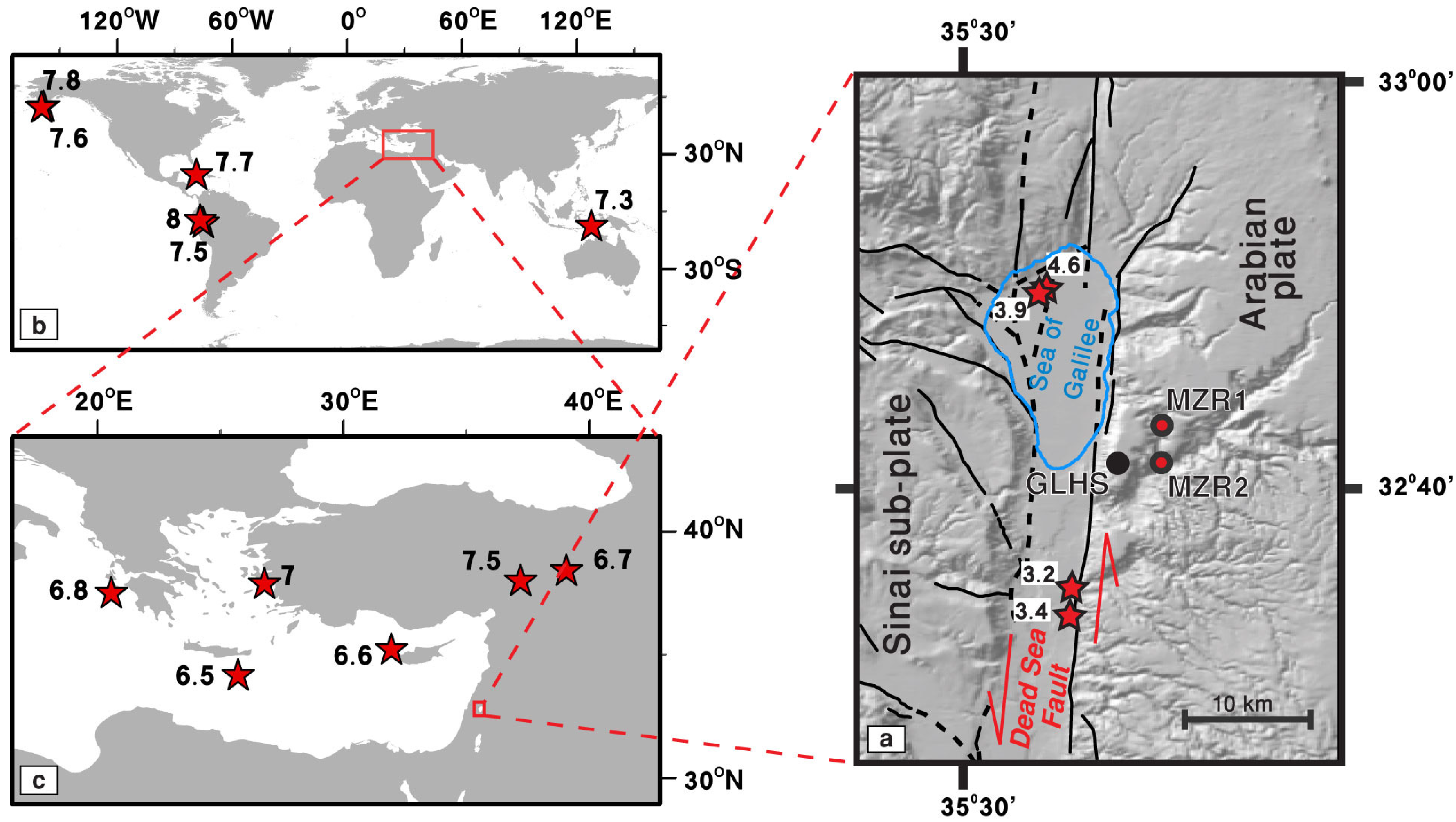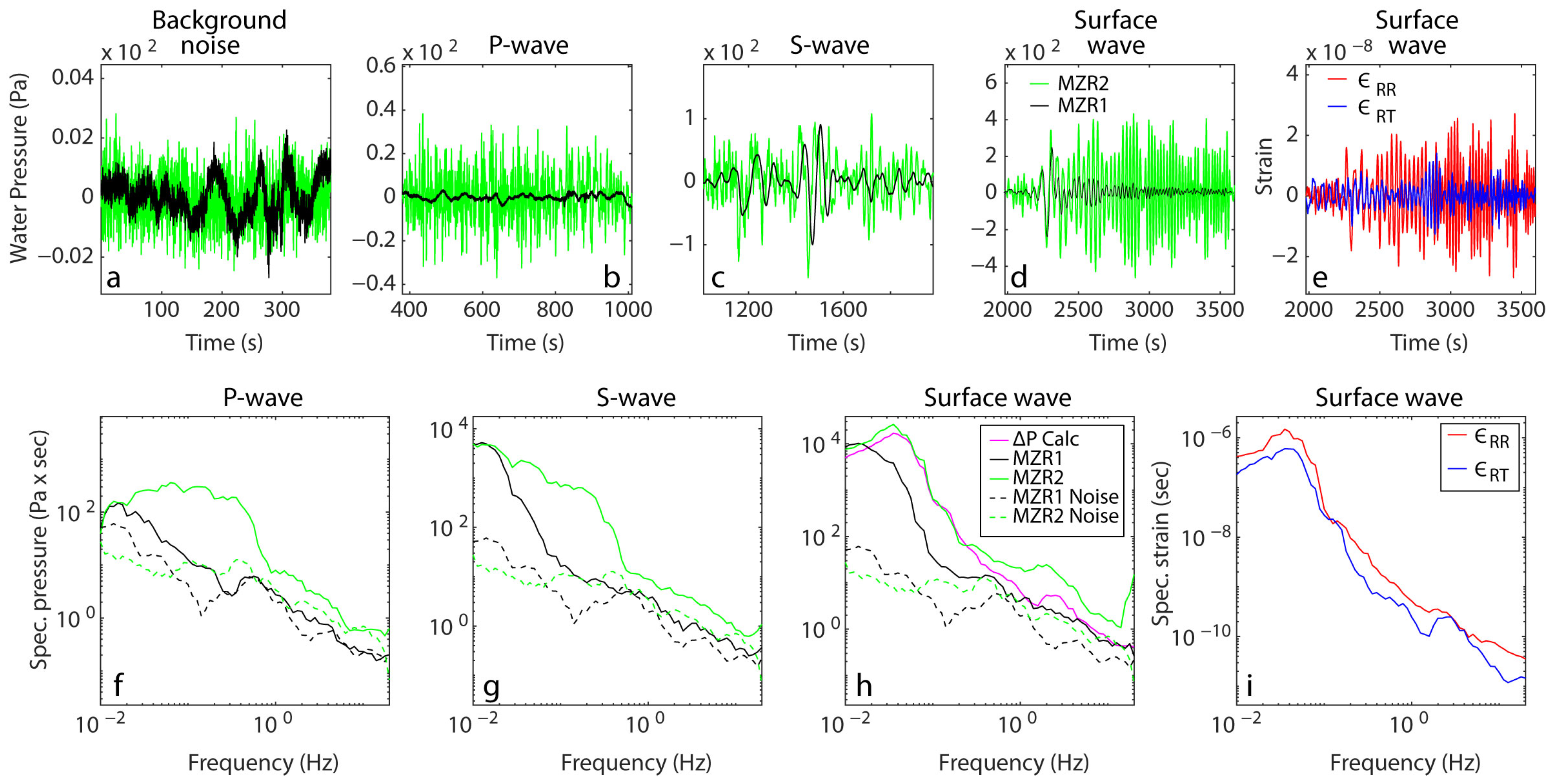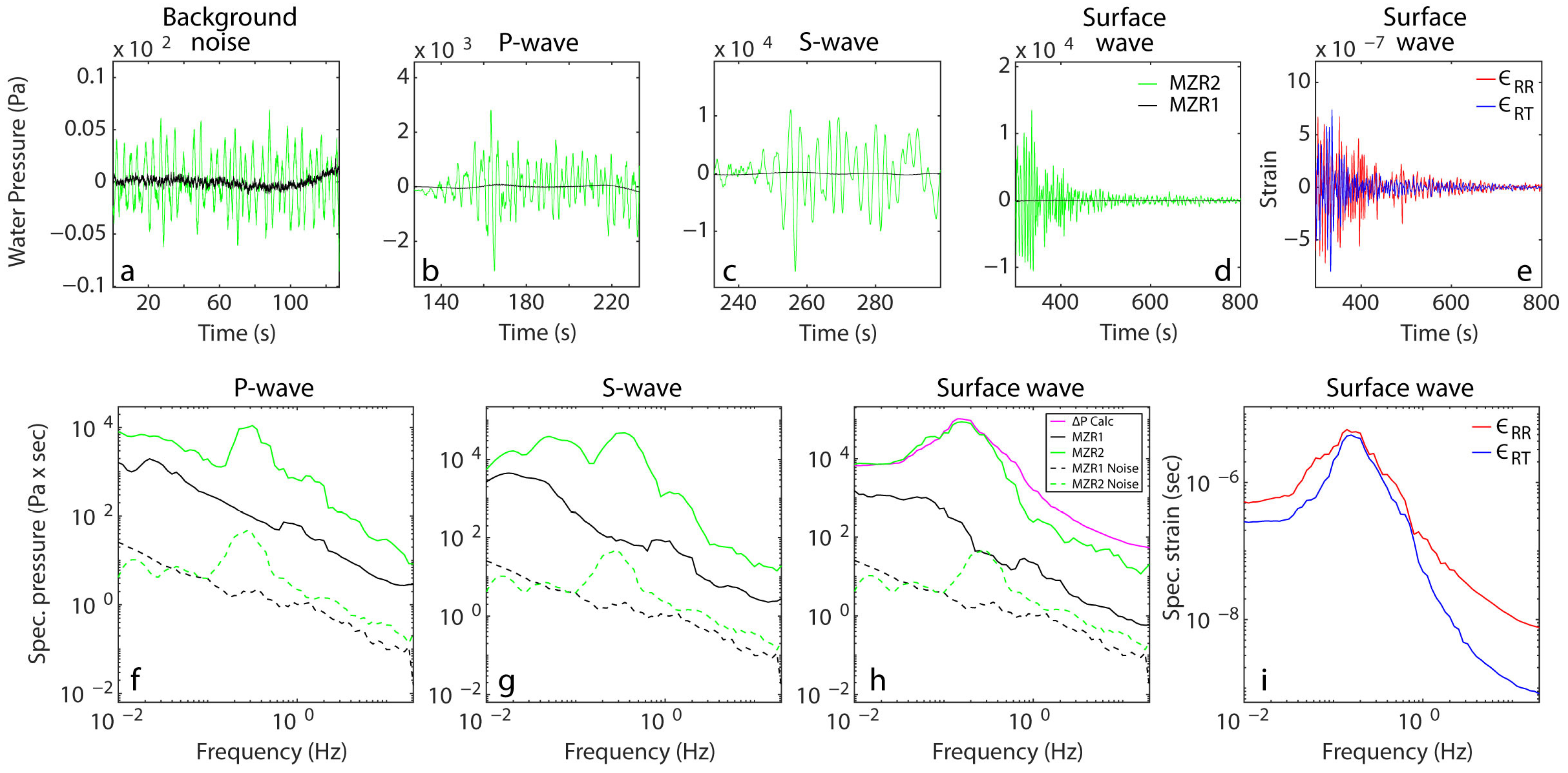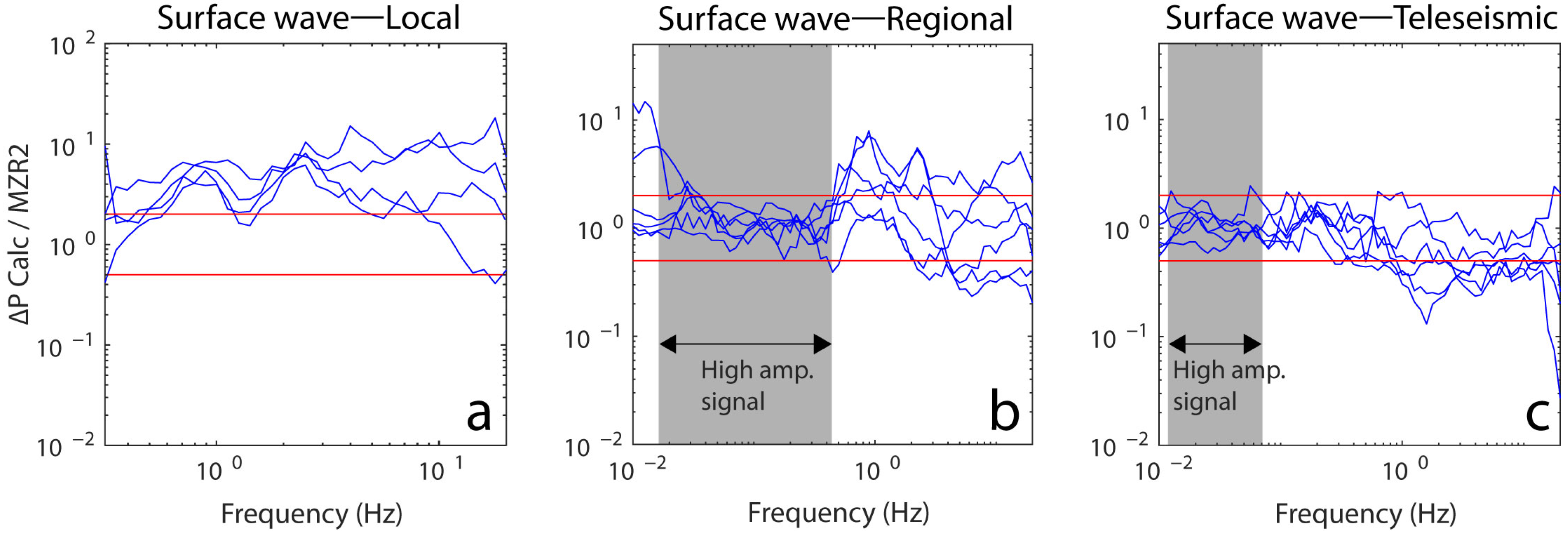Water Level Response to Earthquakes in an Open Well and in a Closed Well—Analysis of Field Observations
Abstract
1. Introduction
2. Study Area
3. Methods
3.1. Groundwater and Ground Motion Measurements
3.2. Seismic Data Processing
4. Results
5. Discussion
5.1. Open Well vs. Closed Well
5.2. Pressure Oscillations in a Closed Well Induced by Surface Waves
6. Conclusions
Supplementary Materials
Author Contributions
Funding
Data Availability Statement
Acknowledgments
Conflicts of Interest
References
- Cooper, H.H., Jr.; Bredehoeft, J.D.; Papadopulos, I.S.; Bennett, R.R. The Response of Well-Aquifer Systems to Seismic Waves. J. Geophys. Res. 1965, 70, 3915–3926. [Google Scholar] [CrossRef]
- Kitagawa, Y.; Itaba, S.; Matsumoto, N.; Koizumi, N. Frequency Characteristics of the Response of Water Pressure in a Closed Well to Volumetric Strain in the High-Frequency Domain. J. Geophys. Res. Solid Earth 2011, 116, 1–12. [Google Scholar] [CrossRef]
- Brodsky, E.E.; Roeloffs, E.; Woodcock, D.; Gall, I.; Manga, M. A Mechanism for Sustained Groundwater Pressure Changes Induced by Distant Earthquakes. J. Geophys. Res. Solid Earth 2003, 108, 2390. [Google Scholar] [CrossRef]
- Roeloffs, E. Poroelastic Techniques in the Study of Earthquake-Related Hydrologic Phenomena. In Advances in Geophysics; Dmowska, R., Saltzman, B., Eds.; Elsevier: Amsterdam, The Netherlands, 1996; Volume 37, pp. 135–195. [Google Scholar]
- Liu, L.-B.; Roeloffs, E.; Zheng, X.-Y. Seismically Induced Water Level Fluctuations in the Wali Well, Beijing, China. J. Geophys. Res. Solid Earth 1989, 94, 9453–9462. [Google Scholar] [CrossRef]
- Cao, M.; Xue, L.; Zhao, L. Investigating Well Water Level Oscillations Caused by Seismic Waves Using Automatically Detected Responses. J. Hydrol. 2024, 639, 131628. [Google Scholar] [CrossRef]
- Isaya, D.; De Luca, G.; Di Carlo, G.; Guerriero, V.; Martorana, R.; Tallini, M. Hydroseismograms at Gran Sasso Aquifer, Central Italy, for Earthquake Hydrology Studies. Sci. Rep. 2025, 15, 13162. [Google Scholar] [CrossRef]
- Hsieh, P.A.; Bredehoeft, J.D.; Farr, J.M. Determination of Aquifer Transmissivity from Earth Tide Analysis. Water Resour. Res. 1987, 23, 1824–1832. [Google Scholar] [CrossRef]
- Wang, C.; Chia, Y. Mechanism of Water Level Changes during Earthquakes: Near Field versus Intermediate Field. Geophys. Res. Lett. 2008, 35, L12402. [Google Scholar] [CrossRef]
- Wang, C.Y.; Manga, M. Hydrologic Responses to Earthquakes and a General Metric. Geofluids 2010, 10, 206–216. [Google Scholar] [CrossRef]
- Cucci, L.; Castellano, C.; Tertulliani, A. A Dataset of Hydrological Effects Induced by Historical and Modern Earthquakes in Southern Apennines (Italy). Sci. Data 2025, 12, 879. [Google Scholar] [CrossRef]
- Sanz de Ojeda, A.; Alhama, I.; Sanz, E. Aquifer Sensitivity to Earthquakes: The 1755 Lisbon Earthquake. J. Geophys. Res. Solid Earth 2019, 124, 8844–8866. [Google Scholar] [CrossRef]
- Weingarten, M.; Ge, S. Insights into Water Level Response to Seismic Waves: A 24 Year High-Fidelity Record of Global Seismicity at Devils Hole. Geophys. Res. Lett. 2014, 41, 74–80. [Google Scholar] [CrossRef]
- Shalev, E.; Kurzon, I.; Doan, M.-L.; Lyakhovsky, V. Sustained Water-Level Changes Caused by Damage and Compaction Induced by Teleseismic Earthquakes. J. Geophys. Res. Solid Earth 2016, 121, 4943–4954. [Google Scholar] [CrossRef]
- Kano, Y.; Yanagidani, T. Broadband Hydroseismograms Observed by Closed Borehole Wells in the Kamioka Mine, Central Japan: Response of Pore Pressure to Seismis Waves from 0.05 to 2 Hz. J. Geophys. Res. Solid Earth 2006, 111, B03410. [Google Scholar] [CrossRef]
- Xing, Y.; Liu, Q.; Hu, R.; Gu, H.; Taherdangkoo, R.; Ptak, T. Global Sensitivity Analysis of Water Level Response to Harmonic Aquifer Disturbances through a Monte-Carlo Based Surrogate Model with Random Forest Algorithm. J. Hydrol. 2024, 641, 131775. [Google Scholar] [CrossRef]
- Hilton, A.; Jasechko, S. Widespread Aquifer Depressurization after a Century of Intensive Groundwater Use in USA. Sci. Adv. 2023, 9, eadh2992. [Google Scholar] [CrossRef]
- Ma, Y.; Huang, F. Coseismic Water Level Changes Induced by Two Distant Earthquakes in Multiple Wells of the Chinese Mainland. Tectonophysics 2017, 694, 57–68. [Google Scholar] [CrossRef]
- Yan, R.; Woith, H.; Wang, R. Groundwater Level Changes Induced by the 2011 Tohoku Earthquake in China Mainland. Geophys. J. Int. 2014, 199, 533–548. [Google Scholar] [CrossRef]
- Shi, Z.; Wang, G.; Manga, M.; Wang, C.-Y. Continental-Scale Water-Level Response to a Large Earthquake. Geofluids 2015, 15, 310–320. [Google Scholar] [CrossRef]
- Montgomery, D.R.; Manga, M. Streamflow and Water Well Responses to Earthquakes. Science 2003, 300, 2047–2049. [Google Scholar] [CrossRef]
- Liao, X.; Wang, G.; Shi, Z. Sustained Changes in Well Water Levels Following a Large Earthquake: Possible Evidence of Permeability Decreases in a Shallow Groundwater System. Geophys. Res. Lett. 2021, 48, e2020GL090232. [Google Scholar] [CrossRef]
- Lan, S.; Gu, H.; Liu, Y. Changes in Groundwater Level and Tidal Response Caused by the Wenchuan Earthquake, China. Hydrogeol. J. 2021, 29, 1329–1341. [Google Scholar] [CrossRef]
- Shi, Z.; Wang, C.-Y.; Yan, R. Frequency-Dependent Groundwater Response to Earthquakes in Carbonate Aquifer. J. Hydrol. 2021, 603, 127153. [Google Scholar] [CrossRef]
- Wang, M.; Gu, H.; Liu, Q.; Wei, H.; Xu, Y.; Lan, S.; Jing, H.; Sauter, M. Effects of Wellbore and Skin Zone on Co-Seismic Water Level Responses: A Numerical Study. J. Hydrol. 2024, 646, 132350. [Google Scholar] [CrossRef]
- Shalev, E.; Malik, U.; Lutzky, H. Monitoring and Analysis of Level and Flow Data in Meizar Wells; Rep. GSI-07-2015; Israel Geological Survey: Jerusalem, Israel, 2015; 17p. (In Hebrew) [Google Scholar]
- Siebert, C.; Möller, P.; Magri, F.; Shalev, E.; Rosenthal, E.; Al-Raggad, M.; Rödiger, T. Applying Rare Earth Elements, Uranium, and 87Sr/86Sr to Disentangle Structurally Forced Confluence of Regional Groundwater Resources: The Case of the Lower Yarmouk Gorge. Geofluids 2019, 2019, 6727681. [Google Scholar] [CrossRef]
- Kurzon, I.; Nof, R.N.; Laporte, M.; Lutzky, H.; Polozov, A.; Zakosky, D.; Shulman, H.; Goldenberg, A.; Tatham, B.; Hamiel, Y. The “TRUAA” Seismic Network: Upgrading the Israel Seismic Network—Toward National Earthquake Early Warning System. Seismol. Res. Lett. 2020, 91, 3236–3255. [Google Scholar] [CrossRef]
- U.S. Geological Survey USGS Earthquake Catalog. Available online: https://earthquake.usgs.gov/earthquakes/search/ (accessed on 1 March 2023).
- Geological Survey of Israel Earthquake Catalog. Available online: https://seis.gsi.gov.il/ (accessed on 1 March 2023).
- Shearer, P.M. Introduction to Seismology, 2nd ed.; Cambridge University Press: Cambridge, UK, 2009. [Google Scholar]
- Bormann, P. (Ed.) New Manual of Seismological Observatory Practice (NMSOP-2); IASPEI, GFZ German Research Centre for Geosciences: Potsdam, Germany, 2012. [Google Scholar]
- Lay, T.; Wallace, T. Modern Global Seimology; Academic Press, Inc.: Cambridge, MA, USA, 1995; Volume 58, 521p. [Google Scholar]
- Skempton, A.W. The Pore-Pressure Coefficients A and B. Géotechnique 1954, 4, 143–147. [Google Scholar] [CrossRef]
- Shalev, E.; Kurzon, I.; Doan, M.L.; Lyakhovsky, V. Water-Level Oscillations Caused by Volumetric and Deviatoric Dynamic Strains. Geophys. J. Int. 2016, 204, 841–851. [Google Scholar] [CrossRef]
- Freeze, R.A.; Cherry, J.A. Groundwater; Prentice-Hall, Inc.: Englewood Cliffs, NJ, USA, 1979; ISBN 0-13-365312-9. [Google Scholar]
- Barbour, A.J.; Beeler, N.M. Teleseismic Waves Reveal Anisotropic Poroelastic Response of Wastewater Disposal Reservoir. Earth Planet. Phys. 2021, 5, 547–558. [Google Scholar] [CrossRef]
- Roded, R.; Shalev, E.; Katoshevski, D. Basal Heat-Flow and Hydrothermal Regime at the Golan–Ajloun Hydrological Basins. J. Hydrol. 2013, 476, 200–211. [Google Scholar] [CrossRef]
- Sneh, A.; Bartov, Y.; Rosensaft, M.; Weissbrod, T. Geological Map of Israel, 1:200,000; GSI Rep. GSI/8/2001; Geological Survey of Israel: Jerusalem, Israel, 1998. [Google Scholar]
- Fleischer, L. Stratigraphic Table of Israel Outcrops and Subsurface, Compilation. Plate VIII. Geol. Framew. Levant. Levantine Basin Isr. 2002, 2, 553–577. [Google Scholar]
- Kawecki, M.W. Correction for Temperature Effect in the Recovery of a Pumped Well. Groundwater 1995, 33, 917–926. [Google Scholar] [CrossRef]










| Well Name | Latitude (°N) | Longitude (°E) | Wellhead Elevation (m AMSL) | Well Total Depth (m) | Well Casing Depth (m) | Well Casing Diameter (m) | Well Uncased Depth (m) | Well Uncased Diameter (m) | Aquifer Lithology | Aquifer Type | Well Type |
|---|---|---|---|---|---|---|---|---|---|---|---|
| MZR1 | 32.74194 | 35.69622 | 56.77 | 1250 | 0 to 385 | 0.47 | 964 to 1250 | 0.31 | dolostone | confined | open |
| 385 to 964 | 0.34 | ||||||||||
| MZR2 | 32.71499 | 35.69607 | −104.15 | 807 | 0 to 89 | 0.51 | 448 to 807 | 0.31 | mostly dolostone and also some limestone, chalk, and marl | confined | closed |
| 89 to 416 | 0.38 | ||||||||||
| 416 to 448 | 0.34 |
| Origin Time (UTC) | Mw | Latitude (°N) | Longitude (°E) | Depth (Km) | Region | EQ Type | Back Azimuth (°) | Distance to GLHS (°) |
|---|---|---|---|---|---|---|---|---|
| 4 Jul 2018 19:45:39 | 4.6 | 32.8558 | 35.5789 | 8 | Sea of Galilee | Local | 337 | 0.16 |
| 8 Jul 2018 13:30:48 | 3.9 | 32.8503 | 35.5824 | 6 | Sea of Galilee | Local | 338 | 0.15 |
| 11 May 2020 02:38:21 | 3.2 | 32.575 | 35.6217 | 13 | Jordan Valley | Local | 190 | 0.14 |
| 22 Jan 2022 21:36:53 | 3.4 | 32.6164 | 35.6226 | 1 | Jordan Valley | Local | 193 | 0.10 |
| 25 Oct 2018 22:54:53 | 6.8 | 37.5203 | 20.5565 | 14 | Greece | Regional | 296 | 13.23 |
| 24 Jan 2020 17:55:14 | 6.7 | 38.4312 | 39.0609 | 10 | Turkey | Regional | 25 | 6.35 |
| 2 May 2020 12:51:06 | 6.5 | 34.1818 | 25.7101 | 10 | Greece | Regional | 283 | 8.42 |
| 30 Oct 2020 11:51:27 | 7 | 37.8973 | 26.7838 | 21 | Greece | Regional | 308 | 8.89 |
| 11 Jan 2022 01:07:48 | 6.6 | 35.2288 | 31.944 | 21 | Cyprus | Regional | 310 | 3.97 |
| 6 Feb 2023 10:24:49 | 7.5 | 38.0106 | 37.1962 | 7 | Turkey | Regional | 13 | 5.45 |
| 26 May 2019 07:41:15 | 8 | −5.8119 | −75.2697 | 123 | Peru | Teleseismic | 277 | 110.71 |
| 28 Jan 2020 19:10:25 | 7.7 | 19.4193 | −78.756 | 15 | Jamaica | Teleseismic | 300 | 98.52 |
| 22 Jul 2020 06:12:45 | 7.8 | 55.0715 | −158.596 | 28 | Alaska | Teleseismic | 8 | 91.37 |
| 19 Oct 2020 20:54:39 | 7.6 | 54.602 | −159.6258 | 28 | Alaska | Teleseismic | 9 | 91.70 |
| 28 Nov 2021 10:52:15 | 7.5 | −4.4667 | −76.8126 | 126 | Peru | Teleseismic | 279 | 111.26 |
| 29 Dec 2021 18:25:52 | 7.3 | −7.5482 | 127.5773 | 165 | Timor Leste | Teleseismic | 95 | 95.68 |
Disclaimer/Publisher’s Note: The statements, opinions and data contained in all publications are solely those of the individual author(s) and contributor(s) and not of MDPI and/or the editor(s). MDPI and/or the editor(s) disclaim responsibility for any injury to people or property resulting from any ideas, methods, instructions or products referred to in the content. |
© 2025 by the authors. Licensee MDPI, Basel, Switzerland. This article is an open access article distributed under the terms and conditions of the Creative Commons Attribution (CC BY) license (https://creativecommons.org/licenses/by/4.0/).
Share and Cite
Lutzky, H.; Kurzon, I.; Gvirtzman, H.; Lyakhovsky, V.; Shalev, E. Water Level Response to Earthquakes in an Open Well and in a Closed Well—Analysis of Field Observations. Water 2025, 17, 2453. https://doi.org/10.3390/w17162453
Lutzky H, Kurzon I, Gvirtzman H, Lyakhovsky V, Shalev E. Water Level Response to Earthquakes in an Open Well and in a Closed Well—Analysis of Field Observations. Water. 2025; 17(16):2453. https://doi.org/10.3390/w17162453
Chicago/Turabian StyleLutzky, Hallel, Ittai Kurzon, Haim Gvirtzman, Vladimir Lyakhovsky, and Eyal Shalev. 2025. "Water Level Response to Earthquakes in an Open Well and in a Closed Well—Analysis of Field Observations" Water 17, no. 16: 2453. https://doi.org/10.3390/w17162453
APA StyleLutzky, H., Kurzon, I., Gvirtzman, H., Lyakhovsky, V., & Shalev, E. (2025). Water Level Response to Earthquakes in an Open Well and in a Closed Well—Analysis of Field Observations. Water, 17(16), 2453. https://doi.org/10.3390/w17162453







